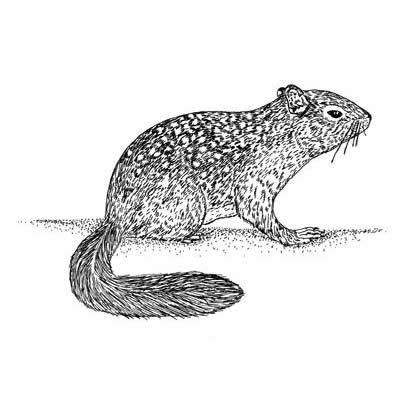 Rock Squirrels - December 27, 2017 Jeff Schalau, Agent, Agriculture & Natural Resources University of Arizona Cooperative Extension, Yavapai County Rock squirrels (Spermophilus variegatus - sometimes called ground squirrels) are found in many areas of Arizona. In wildland areas, they provide beneficial ecosystem services such as disseminating seeds, loosening compacted soils, and feeding carnivorous animals and raptors. In residential areas, their presence can be damaging to landscape and garden plants, compromise structures, and even hazardous to human health. Rock squirrels are relatively large, heavy-bodied, and have moderately long, bushy tail. The head and body are about 10.5 inches long and the tail is approximately 8 inches. Their fur is usually brownish gray and mottled with white spots. Rock squirrels live in open burrows (as opposed to a gopher’s closed burrow system) and prefer rocky areas, but often burrow under human-made structures, irrigation ditch banks, and the edges of cultivated fields. They are active during daylight hours (diurnal), usually eating plant matter, but occasionally feeding on insects and road killed animals. Rock squirrels need very little free water obtaining what they need from dew, succulent vegetation, bulbs, and bark. They hibernate in colder areas and emerge in spring to feed on green vegetation. As spring growth dries up, they begin to feed on seeds and fruits of plants including acorns, juniper berries, pine nuts, mesquite buds and beans, cactus, and other native plants. Rock squirrels have cheek pouches and will horde and cache food. Rock squirrel mating season is between March and July and after a 30-day gestation period, a litter of 5 to 7 pups are born. One litter is produced per year. The pups are born hairless and raised in a nest of grass inside the burrow for about 6 to 7 weeks before they venture above ground. Rock squirrel burrows protect them from weather and predators. The burrow system is expanded each year and multiple entrances are common. Burrows entrances are serious hazards and should not be allowed to exist in equestrian areas, parks, schools, and other public areas. The burrows often extend under sidewalks, dwellings, and outbuildings where they can weaken structural integrity. Rock squirrels are also associated with transmission of bubonic plague to humans. For these reasons, property owners and public organizations should not allow them to exist where they pose unnecessary risks. As with many pest problems, an integrated approach using multiple control methods will be most effective. Fences are generally ineffective in excluding ground squirrels. Removal of debris piles, irrigation pipe, pallets, and rock piles can discourage rock squirrels. Frightening and repellents do not usually deter rock squirrels. Shooting is not recommended for safety and legal reasons. Toxic baits and fumigants can be very effective. However, these products are best used by licensed pesticide applicators to prevent harm to non-target species. Trapping can be used by do-it-yourselfers. It is most effective on small populations and can be done any time rock squirrels are active. Traps can be baited with walnuts, almonds, orange slices, or pieces of melon. Always wear disposable latex gloves when handling and disposing of deceased squirrels and be aware of local reports of bubonic plague. Once the squirrel population has been controlled, destroy the burrow system to prevent reestablishment. The question of live traps always comes up. Live traps can be used, but the trapped animal should be humanely euthanized. When animals are released within ˝ mile, they often return to their burrow. Those that do not return can become someone else’s problem or they are unfamiliar with the release area and are highly subject to death from predators or starvation. Transporting the animal can also increase risks of human exposure to disease. If you have rock squirrels, you will see them. If you see them often, you should inspect your property for burrows and other damage. They are not usually friendly neighbors and removing them can be a lengthy process. Below are two additional resources on management of rock squirrels. Follow the Backyard Gardener on Twitter – use the link on the BYG website. If you have other gardening questions, call the Master Gardener help line in the Camp Verde office at 928-554-8992 or e-mail us at verdevalleymg@gmail.com and be sure to include your name, address and phone number. Find past Backyard Gardener columns or provide feedback at the Backyard Gardener web site: http://cals.arizona.edu/yavapai/anr/hort/byg/. Additional Resources Controlling Rock Squirrel Damage in New Mexico New Mexico State University Cooperative Extension Service aces.nmsu.edu/pubs/_circulars/Cr-574.pdf Ground Squirrel University of California Extension www.ipm.ucdavis.edu/PMG/PESTNOTES/pn7438.html |